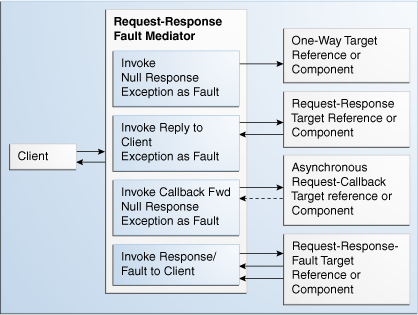Request-Reply-Fault Message Exchange Patterns
In a request-reply-fault interaction, the Mediator is invoked and sends a reply and one or more faults back to the caller. Depending on the type of routing rule target, the responses, faults, and callbacks are handled as shown in Table 24-4:
Table 24-4 Response When Mediator's WSDL Is a Request Reply Fault
| Routing Rule Target Type | Response |
|---|---|
|
Request |
There should be at least one sequential routing rule with a request-response-fault service. Mediator returns |
|
Request Response |
The response is sent back to the caller. Any exception in Mediator message processing may result in a fault. |
|
Request Response Fault |
The response and fault are sent back to the caller. Any exception in Mediator message processing may result in a fault. |
|
Request Callback |
There is no response from the target, but there should be at least one sequential routing rule with a request-response service. Mediator returns |
|
Request Response Callback |
The response is sent back to the caller. Any exception in Mediator message processing may result in a fault. |
|
Request Response Fault Callback |
The response and fault are sent back to the caller. Any exception in Mediator message processing may result in a fault. |
Figure 24-3 illustrates the request-reply-fault message exchange pattern.
Figure 24-3 Request-Reply-Fault Message Exchange Pattern

Description of "Figure 24-3 Request-Reply-Fault Message Exchange Pattern"